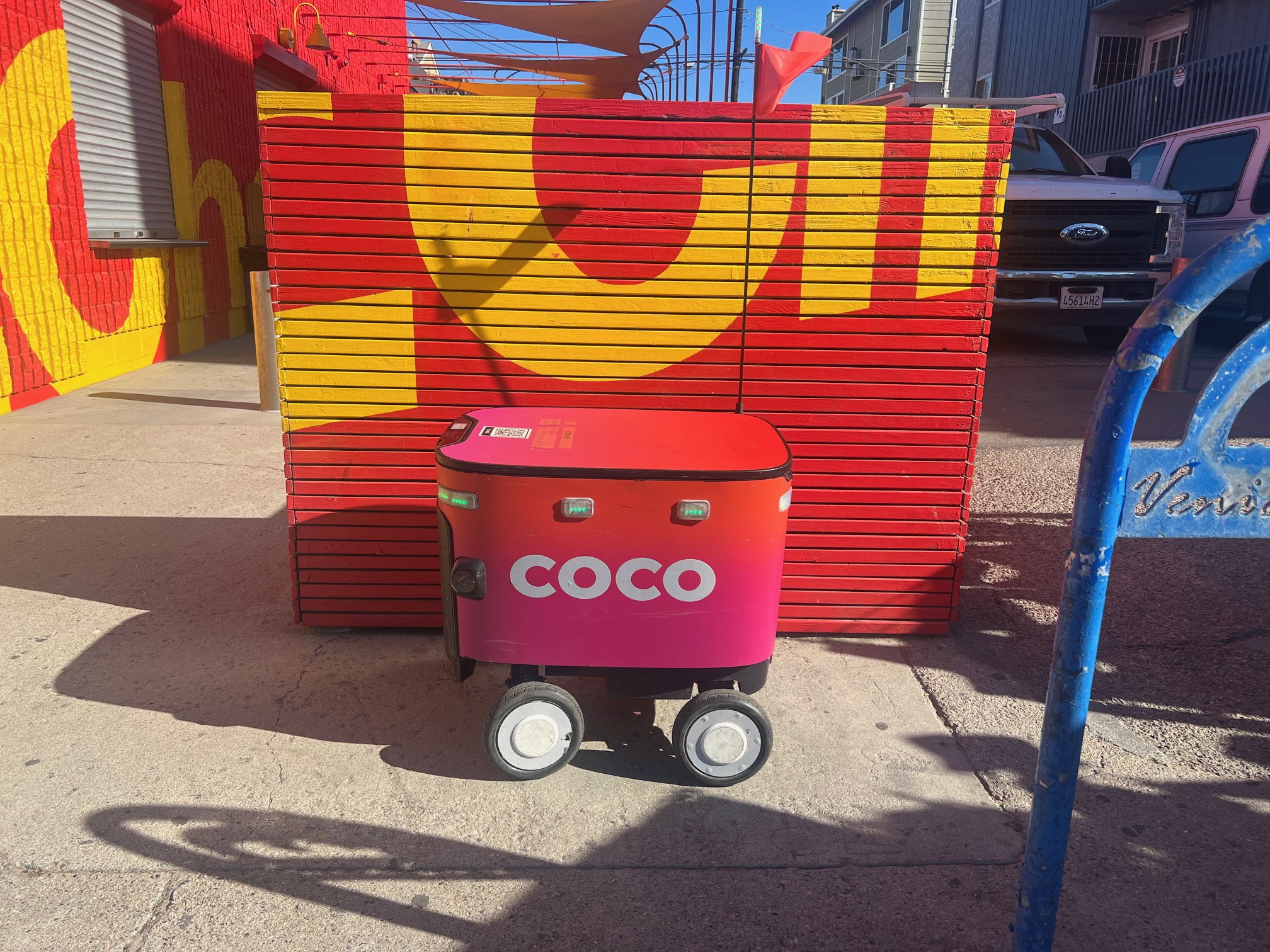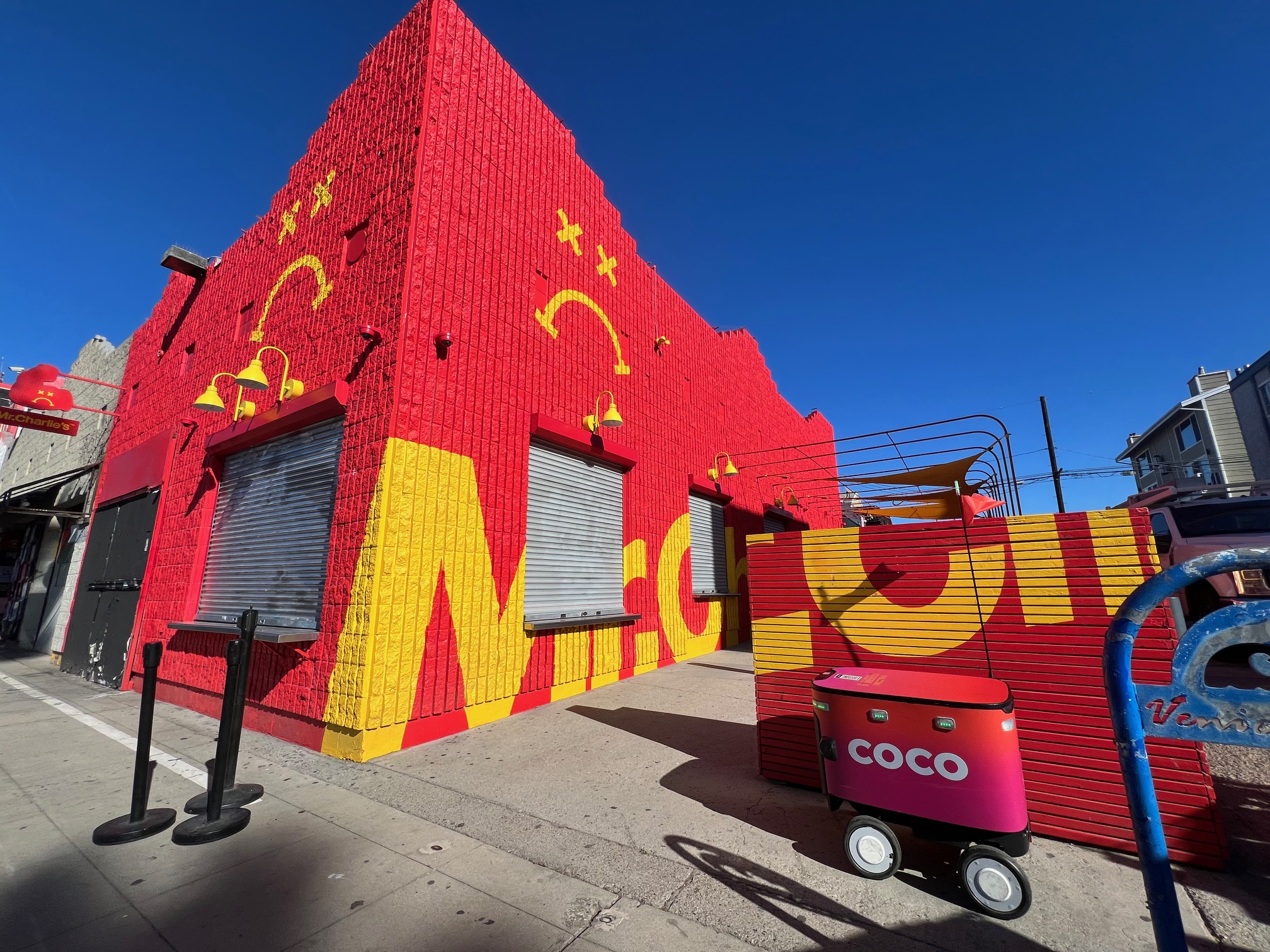While competitors like Starship and Serve Robotics have gained national attention for using their autonomous bots to deliver 7-Eleven Slurpees, Shake Shack burgers and college meals, robot startup Coco has been quietly operating under the radar.
Under CEO and cofounder Zach Rash, Coco has been modifying for the last few years its human-operated robots to meet the demands of urban delivery, where sidewalk bots must navigate multiple obstacles.
Coco’s fleet of more than 1,000 emissions-free robots is now ready for prime time.
Uber Eats has tapped Coco’s sidewalk robots for deliveries in Los Angeles. The move expands Uber Eats’ deployment of foodservice robots. The third-party delivery provider currently has partnerships with Cartken and Serve Robotics.
“As we continue to popularize robot delivery in Los Angeles, our partnership with Coco drives us another step towards a more sustainable and autonomous future for delivery,” Noah Zych, global head of autonomous mobility & delivery at Uber, said in a statement.
A handful of Coco’s robots began Los Angeles area deliveries with Uber Eats last week. In the coming weeks, hundreds more will be deployed, delivering meals from Los Angeles area restaurants, including Dog Haus.

Coco’s robots are stationed at dozens of restaurants in Los Angeles.
“With our rapidly growing fleet we’re in a unique position to bring unprecedented scale to this partnership and deliver the benefits of sustainable and affordable robot delivery to more customers around the world,” Rash said in a statement.
The partnership with Uber Eats marks a significant move for Coco, which began deploying remote-controlled robots in Southern California during the pandemic. Previously, deliveries were completed through direct partnerships with restaurants or through Coco’s app.
‘Reliability is everything’
Over the past two years, Coco has modified its robots and expanded the fleet from 100 to 1,000.
“We’ve scaled up the fleet quite a bit,” Rash told Food on Demand.
Adjustments made to ensure the speed and accuracy of its food deliveries included adding cup holders and improving insulation to accommodate both hot and cold items.
“This is a business where reliability is everything,” said Rash. “Our goal is to have the most consistent platform possible.”
Coco is among a handful of companies deploying fleets of foodservice delivery robots. Others include Serve Robotics, Cartken, Starship and Avride.
The robot delivery market is expected to grow to $1.8 billion by 2028, up from $400 million in 2023, according to MarketsandMarkets Research.
Quick market entry
Rash launched Coco in 2020, a year after he graduated from UCLA.
He studied robotics but couldn’t find a job in the delivery-robot space, so he and his UCLA classmate Brad Squicciarini launched their own startup in April 2020. Cyan Robotics, the company’s initial name, dispatched five robots in Santa Monica, Calif. when restaurants were in lockdown.
That was a key strategy for Coco.

A Coco food delivery robot is stationed at Mr.Charlie’s, a plant-based fast-food restaurant in Venice Beach, Calif
Instead of spending years on research and development for autonomous bots, Coco quickly entered the food delivery market during the pandemic by launching remote-controlled sidewalk robots.
Investors took note. By early 2022, the startup had raised a total of $56 million. One of their early backers was former Y Combinator executive Sam Altman, now famous for leading OpenAI.
To date, Coco has raised $72 million.
Evolving to hybrid robots
Rash said the presence of a human operator ensures that the robot can navigate challenging sidewalk situations in high-pedestrian Los Angeles neighborhoods in Hollywood, Santa Monica, and Venice Beach.
“This is a real solution you can rely on 24/7,” he said.
To date, Coco’s robots have completed over 300,000 deliveries in Los Angeles, Houston and Finland.
The bots have evolved into hybrid sidewalk robots that operate autonomously but are supervised by a human operator. Rash said the operator steps in whenever the robot encounters “any complicated scenarios, which happens all the time.”
Rash declined to reveal the number of operators needed to supervise the fleet.
He emphasized that this hybrid model ensures timely food delivery, with most orders reaching residences located about 1 to 2 miles from the restaurant within 30 minutes. This model also avoids the technical delays common among fully autonomous robots, which can get stuck for various reasons.
Rash said robot deliveries are ideal in urban markets because the robots are stationed at or near the restaurant. One robot typically serves at least two restaurants and can be ready to deploy within minutes, unlike a driver who might be delayed by traffic or parking.
“They’re super reliable,” he said.
In the Uber deal, restaurants don’t pay a fee for robot deliveries. Uber Eats pays Coco an undisclosed amount for use of its robots.
As for consumers, there’s one perk that comes with robot delivery.
“There’s no tips for robots,” Rash said.
Nancy Luna is a contributing writer for Food on Demand. She can be reached at [email protected]


